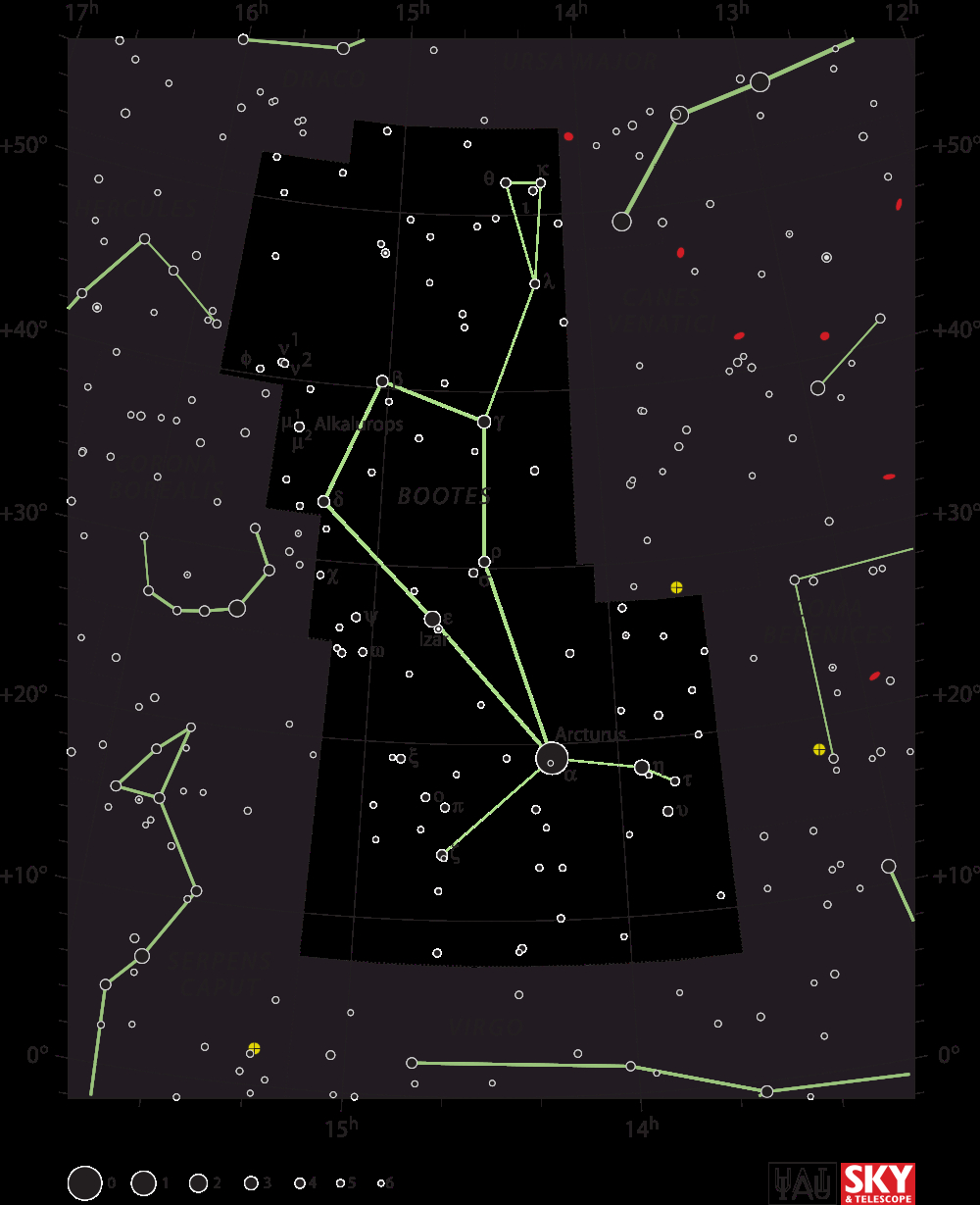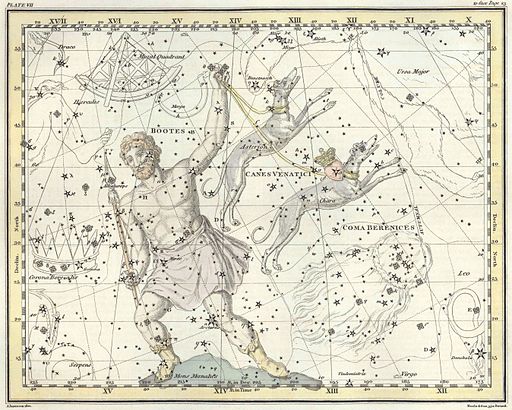
By IAU and Sky & Telescope magazine (Roger Sinnott & Rick Fienberg) [CC-BY-3.0], via Wikimedia Commons
"The Herdsman"

By IAU and Sky & Telescope magazine (Roger Sinnott & Rick Fienberg) [CC-BY-3.0], via Wikimedia Commons
Abbreviation: Boo
Genitive: Boötis
Constellation family: Ursa Major
Nearest constellations: Canes Venatici, Coma Berenices,
Corona Borealis, Draco, Hercules,
Serpens, Ursa Major, and Virgo
Right ascension: 14.73h
Declination: 30.72°
Visible between latitudes: +90° and -50°
Square degrees: 907
Luminary: Arcturus (Alpha Boötis)
Named stars: Arcturus, Nekkar, Seginus, Izar, Muphrid, Alkalurops
Notable deep sky objects: Arp 297 (NGC 5752, NGC 5753, NGC 5754, and NGC 5755)
Boötes is a large constellation in the Northern Hemisphere. It is best seen during June.
Arcturus, the brightest star in Boötes, is also the brightest star in the Northern Hemisphere and the fourth-brightest in the entire night sky.
Boötes is the radiant point of the Quadrantids meteor shower. The shower usually occurs between the last week of December and the first two weeks of January, peaking around January 2-3. The Quadrantids are named after an obsolete constellation called Quadrans Muralis, which was not included as a constellation when the current 88 constellations were defined by the International Astronomical Union (IAU). Due to the disappearance of the original constellation, the Quadrantids are also sometimes called the Boötids.
Boötes contains the Boötes Void, which is a roughly spherical area of space about 75-100 Megaparsecs (or 250-325 light years) across. Voids are areas of space where there are abnormally low levels of matter present and sometimes no matter at all, including both normal matter and dark matter.

By Alexander Jamieson (United States Naval Observatory Library) [Public domain], via Wikimedia Commons
Only 60 galaxies have been discovered in the Boötes Void. Assuming a spacing between galaxies of 10 million light years, which is four times the distance between the Milky Way and the Andromeda Galaxy, one would expect to find 2,000 galaxies in the volume of the Boötes Void. If the Milky Way (and, therefore, the Solar System) had existed in an area with such a low density of matter humanity would not have discovered other galaxies until the 1960s.
Mythology concerning Boötes varies widely. While the English name of Boötes is officially designated as "The Herdsman" by the IAU (International Astronomical Union), the Greek translation of the name Boötes is "ox-driver." The first mention of the constellation occurs in the Greek story The Odyssey by Homer.
The Romans, on the other hand, called the constellation "Venator Ursae", meaning "The Bear Hunter", and it is still occasionally referred to as "The Bear Driver." When viewed as a hunter, the constellation Canes Venatici ("The Hunting Dogs") is often shown as representing Boötes' dogs.
Arp 297 (NGC 5752, NGC 5753, NGC 5754, and NGC 5755), a quartet of spiral galaxies:

By Adam Block/Mount Lemmon SkyCenter/University of Arizona [CC-BY-SA-3.0], via Wikimedia Commons
Close-up of NGC 5752 and NGC 5754:

By NASA, ESA, the Hubble Heritage (STScI/AURA)-ESA/Hubble Collaboration, and W. Keel (University of Alabama, Tuscaloosa) [Public domain], via Wikimedia Commons
NGC 5466 (globular cluster):

By NASA, STScI, WikiSky (WikiSky's snapshot tool) [Public domain], via Wikimedia Commons
UGC 9128 (dwarf irregular galaxy):

By ESA/Hubble & NASA [CC-BY-3.0], via ESA/Hubble